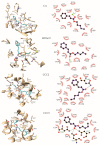Larvicidal Activity of Cinnamic Acid Derivatives: Investigating Alternative Products for Aedes aegypti L. Control
- PMID: 33374484
- PMCID: PMC7796249
- DOI: 10.3390/molecules26010061
Larvicidal Activity of Cinnamic Acid Derivatives: Investigating Alternative Products for Aedes aegypti L. Control
Abstract
The mosquito Aedes aegypti transmits the virus that causes dengue, yellow fever, Zika and Chikungunya viruses, and in several regions of the planet represents a vector of great clinical importance. In terms of mortality and morbidity, infections caused by Ae. aegypti are among the most serious arthropod transmitted viral diseases. The present study investigated the larvicidal potential of seventeen cinnamic acid derivatives against fourth stage Ae. aegypti larvae. The larvicide assays were performed using larval mortality rates to determine lethal concentration (LC50). Compounds containing the medium alkyl chains butyl cinnamate (7) and pentyl cinnamate (8) presented excellent larvicidal activity with LC50 values of around 0.21-0.17 mM, respectively. While among the derivatives with aryl substituents, the best LC50 result was 0.55 mM for benzyl cinnamate (13). The tested derivatives were natural compounds and in pharmacology and antiparasitic studies, many have been evaluated using biological models for environmental and toxicological safety. Molecular modeling analyses suggest that the larvicidal activity of these compounds might be due to a multi-target mechanism of action involving inhibition of a carbonic anhydrase (CA), a histone deacetylase (HDAC2), and two sodium-dependent cation-chloride co-transporters (CCC2 e CCC3).
Keywords: Chikungunya; Zika; cinnamic ester; dengue; larvicidal activity; medicinal plants; mosquitoes; natural products; yellow fever.
Conflict of interest statement
The authors declare no conflict of interest.
Figures







Similar articles
-
Larvicidal activity and in silico studies of cinnamic acid derivatives against Aedes aegypti (Diptera: Culicidae).Bioorg Med Chem. 2021 Aug 15;44:116299. doi: 10.1016/j.bmc.2021.116299. Epub 2021 Jun 28. Bioorg Med Chem. 2021. PMID: 34225166
-
Evaluation of larvicidal, adulticidal, and anticholinesterase activities of essential oils of Illicium verum Hook. f., Pimenta dioica (L.) Merr., and Myristica fragrans Houtt. against Zika virus vectors.Environ Sci Pollut Res Int. 2018 Aug;25(23):22541-22551. doi: 10.1007/s11356-018-2362-y. Epub 2018 May 28. Environ Sci Pollut Res Int. 2018. PMID: 29808407
-
Evaluation of (-)-borneol derivatives against the Zika vector, Aedes aegypti and a non-target species, Artemia sp.Environ Sci Pollut Res Int. 2018 Nov;25(31):31165-31174. doi: 10.1007/s11356-018-2809-1. Epub 2018 Sep 5. Environ Sci Pollut Res Int. 2018. PMID: 30187415
-
Larvicidal activity of terpenes and their derivatives against Aedes aegypti: a systematic review and meta-analysis.Environ Sci Pollut Res Int. 2024 Dec;31(56):64703-64718. doi: 10.1007/s11356-024-35479-w. Epub 2024 Nov 16. Environ Sci Pollut Res Int. 2024. PMID: 39549195
-
Essential oils and their chemical constituents against Aedes aegypti L. (Diptera: Culicidae) larvae.Acta Trop. 2020 Dec;212:105705. doi: 10.1016/j.actatropica.2020.105705. Epub 2020 Sep 19. Acta Trop. 2020. PMID: 32956639 Review.
Cited by
-
Sequence analysis and function of mosquito aeCCC2 and Drosophila Ncc83 orthologs.Insect Biochem Mol Biol. 2022 Apr;143:103729. doi: 10.1016/j.ibmb.2022.103729. Epub 2022 Feb 9. Insect Biochem Mol Biol. 2022. PMID: 35150868 Free PMC article.
-
Nanoemulsions and Solid Microparticles Containing Pentyl Cinnamate to Control Aedes aegypti.Int J Mol Sci. 2023 Jul 29;24(15):12141. doi: 10.3390/ijms241512141. Int J Mol Sci. 2023. PMID: 37569517 Free PMC article.
-
Synthetic Cinnamides and Cinnamates: Antimicrobial Activity, Mechanism of Action, and In Silico Study.Molecules. 2023 Feb 17;28(4):1918. doi: 10.3390/molecules28041918. Molecules. 2023. PMID: 36838906 Free PMC article.
-
Antifungal activity against Candida albicans of methyl 3,5-dinitrobenzoate loaded nanoemulsion.Braz J Microbiol. 2024 Mar;55(1):25-39. doi: 10.1007/s42770-023-01214-9. Epub 2023 Dec 23. Braz J Microbiol. 2024. PMID: 38135805 Free PMC article.
-
Multitarget Compounds for Neglected Diseases: A Review.Curr Drug Targets. 2024;25(9):577-601. doi: 10.2174/0113894501298864240627060247. Curr Drug Targets. 2024. PMID: 38967077 Review.
References
-
- Coelho A.A.M., De Paula J.E., Espíndola L.S. Atividade larvicida de extratos vegetais sobre Aedes aegypti (L.) (Diptera: Culicidae), em condições de laboratório. BioAssay. 2009;4:1–6. doi: 10.14295/BA.v4.0.22. - DOI
-
- Nunes F.C., Leite J.A., Oliveira L.H.G., Sousa P.A.P.S., Menezes M.C., Moraes J.P.S., Mascarenhas S.R., Braga V.A. The larvicidal activity of Agave sisalana against L4 larvae of Aedes aegypti is mediated by internal necrosis and inhibition of nitric oxide production. Parasitol. Res. 2015;114:543–549. doi: 10.1007/s00436-014-4216-y. - DOI - PubMed
-
- Simas N.K., Lima E.C., Conceição S.R., Kuster R.M., de Oliveira Filho A.M. Produtos naturais para o controle da transmissão da dengue – atividade larvicida de Myroxylon balsamum (óleo vermelho) e de terpenóides e fenilpropanóides. Quím. Nova. 2004;27:46–49. doi: 10.1590/S0100-40422004000100009. - DOI
-
- WHO Dengue and Severe Dengue. [(accessed on 17 September 2020)];2020 Available online: https://www.who.int/news-room/fact-sheets/detail/dengue-and-severe-dengue.
MeSH terms
Substances
LinkOut - more resources
Full Text Sources

